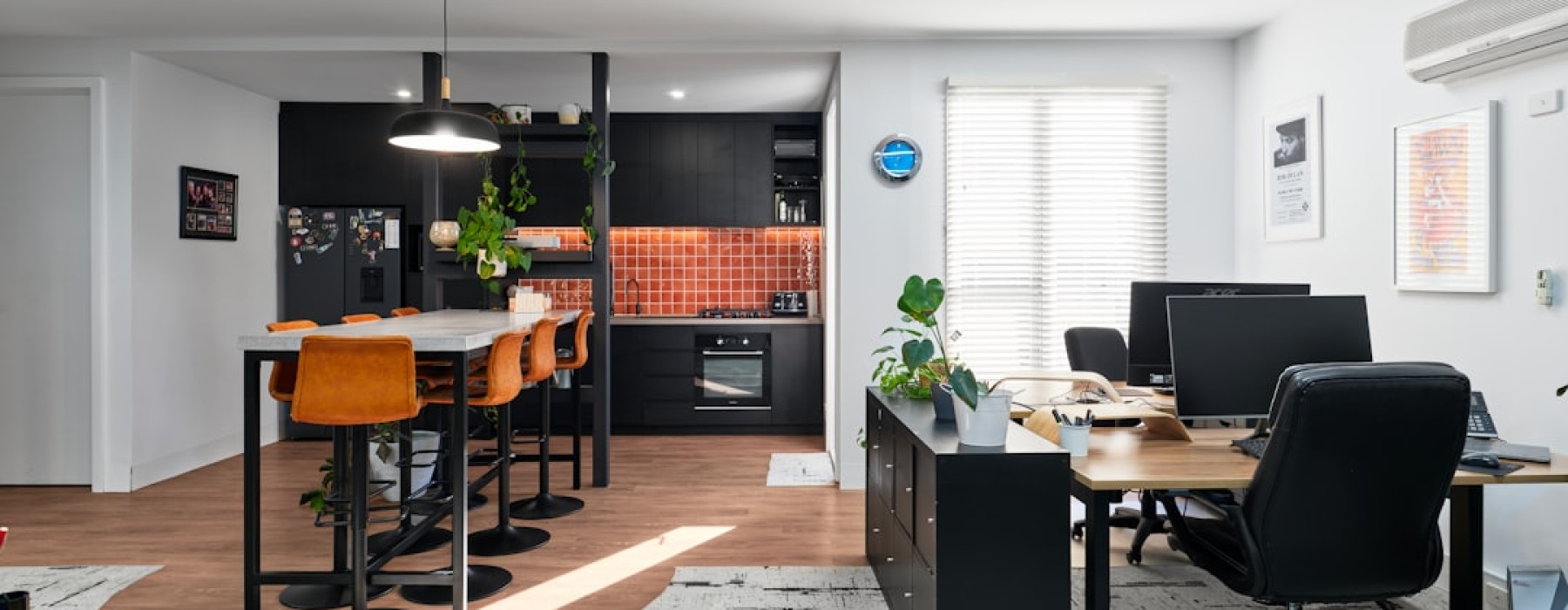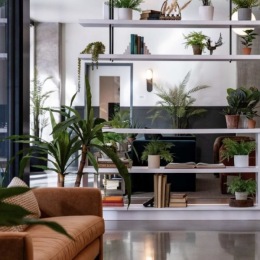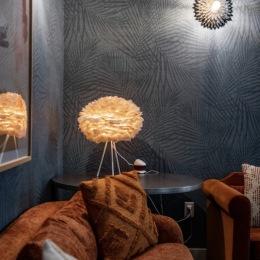Why Apartments with Coworking Spaces Are Changing Modern Living
Apartments with coworking space are reshaping how we think about home and work. These innovative residential communities blend traditional apartment living with professional-grade work environments, creating seamless live-work ecosystems under one roof.
Key Features of Apartments with Coworking Spaces:
- Dedicated work lounges with ergonomic furniture and high-speed Wi-Fi
- Private meeting rooms and phone booths for confidential calls
- Flexible desk options including standing desks and collaborative tables
- 24/7 access to work areas for residents
- Community events and networking opportunities
- Cost savings on external office rentals and commuting
- Improved amenities like on-site cafés and wellness centers
The demand for these hybrid living spaces has exploded. By mid-2022, approximately 900,000 people were using shared workspaces in the U.S., and work-from-home space now leads the list of design trends for apartment developers.
Remote work isn't going anywhere. More companies are embracing hybrid schedules, making coworking a must-have apartment amenity rather than a nice-to-have perk. Property managers report that tenants often pay premium rents for the convenience of having professional workspace just an elevator ride away.
These communities foster genuine connections too. Unlike traditional apartment buildings where neighbors barely interact, coworking-equipped properties create natural networking opportunities through shared work zones and community programming.
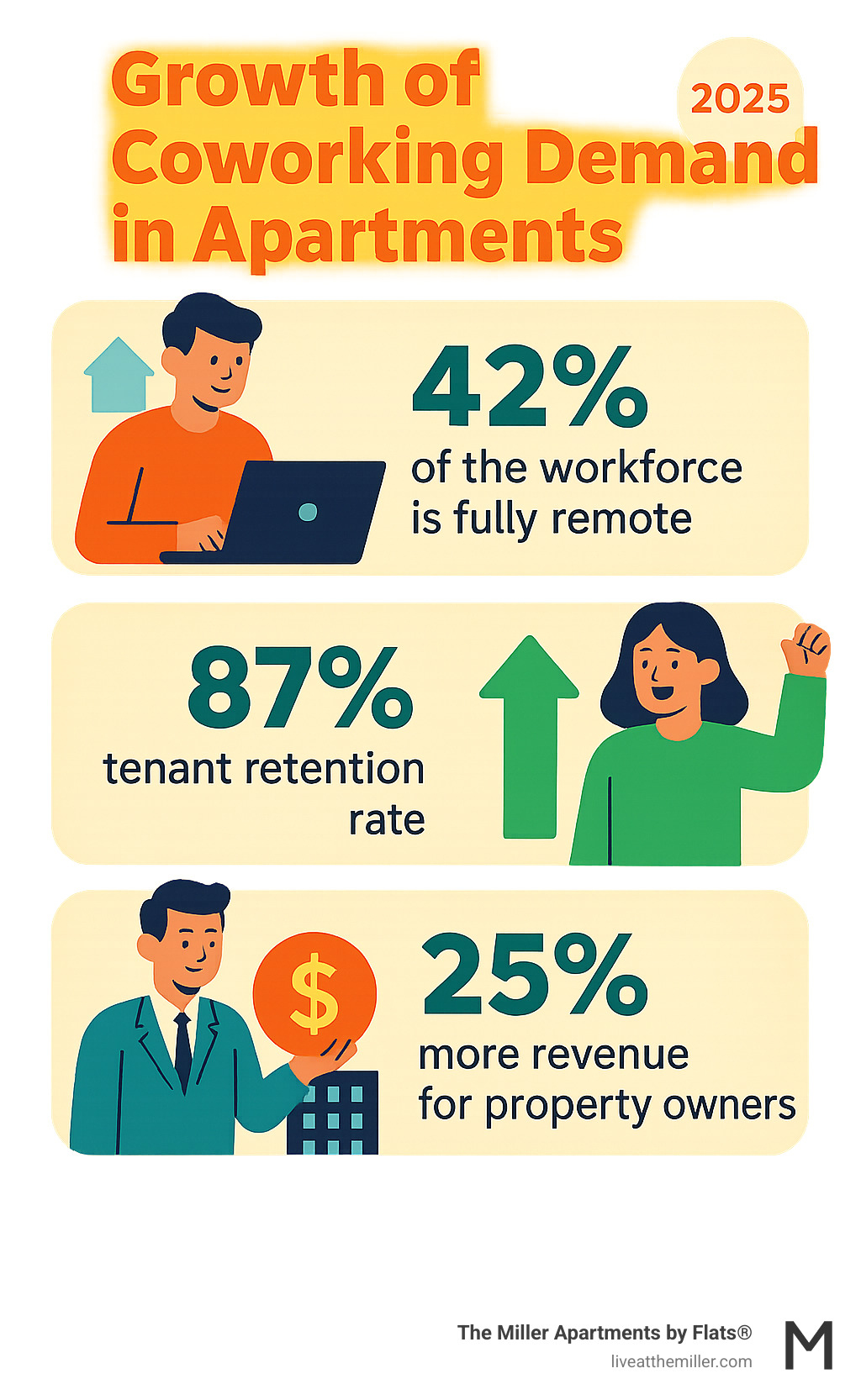
10 Benefits of Apartments with Coworking Spaces
Living in apartments with coworking space changes everything about how you approach your daily routine. These smart residential communities deliver benefits that go way beyond just having a desk nearby – they're reshaping the entire live-work experience.
Convenience of apartments with coworking space
Imagine your daily commute being nothing more than an elevator ride. That's the reality for residents who choose apartments with coworking space. No more sitting in traffic, no more rushing to catch buses, no more parking hassles. You literally roll out of bed, grab your coffee, and you're at your professional workspace within minutes.
The 24/7 access makes all the difference too. Unlike external coworking facilities that lock up at night, your building's workspace is always available. Need to jump on a call with clients in Tokyo at 6 AM? No problem. Working late to meet a deadline? The space is yours whenever you need it.
The cost savings add up quickly. When you factor in gas, parking fees, and what you'd spend on external office space, that slight premium for coworking-equipped living often pays for itself. Many residents find they're actually saving money while gaining convenience.
Community perks of apartments with coworking space
Something magical happens when neighbors become colleagues. The coworking lounge becomes a natural meeting ground where casual conversations spark into genuine friendships and business partnerships. Gone are the days of never knowing who lives next door.
These spaces buzz with activity beyond just individual work. Property managers organize workshops where residents share their skills – maybe the marketing consultant down the hall teaches social media strategy, or the graphic designer offers logo workshops. Networking events become regular highlights that bring the community together.
The networking opportunities feel organic rather than forced. Residents regularly find business partners, find new clients, or connect with mentors simply through their daily work routines. It's professional networking that happens naturally over shared coffee breaks and collaborative projects.
Better work–life boundaries
Here's the surprising part: having work space in your building actually improves work-life balance. Dedicated focus pods and private phone booths let you maintain professional boundaries even when working from home. You can take sensitive calls without worrying about roommates overhearing or handle confidential projects in properly soundproofed spaces.
The physical act of walking to the coworking lounge creates that mental shift between home and work mode. At the end of your workday, you can literally leave your workspace behind and return to your living area. This separation helps remote workers maintain the boundaries that traditional office workers take for granted.
Wellness & time savings
The wellness benefits multiply when everything connects seamlessly. Finish a morning work session, head to the fitness center for a midday workout, then grab lunch at the on-site café. This integration of work, wellness, and nutrition creates healthier daily rhythms that would be impossible with a traditional commute.
The time savings extend far beyond eliminated commutes. Residents can save money on commute costs while gaining hours for personal activities, family time, or pursuing passion projects. Many report feeling less stressed and more productive thanks to this better work-life integration.
Higher tenant loyalty
Property managers consistently see something remarkable: residents in buildings with coworking amenities stay longer. The convenience and community connections create emotional bonds that go beyond typical renter relationships. When your building becomes your workplace and your social hub, moving feels like leaving a whole lifestyle behind.
The bundled amenity fees make the value clear and transparent. Residents understand they're getting premium services that would cost significantly more if purchased separately. This clear value proposition strengthens satisfaction and makes renewal decisions easy.
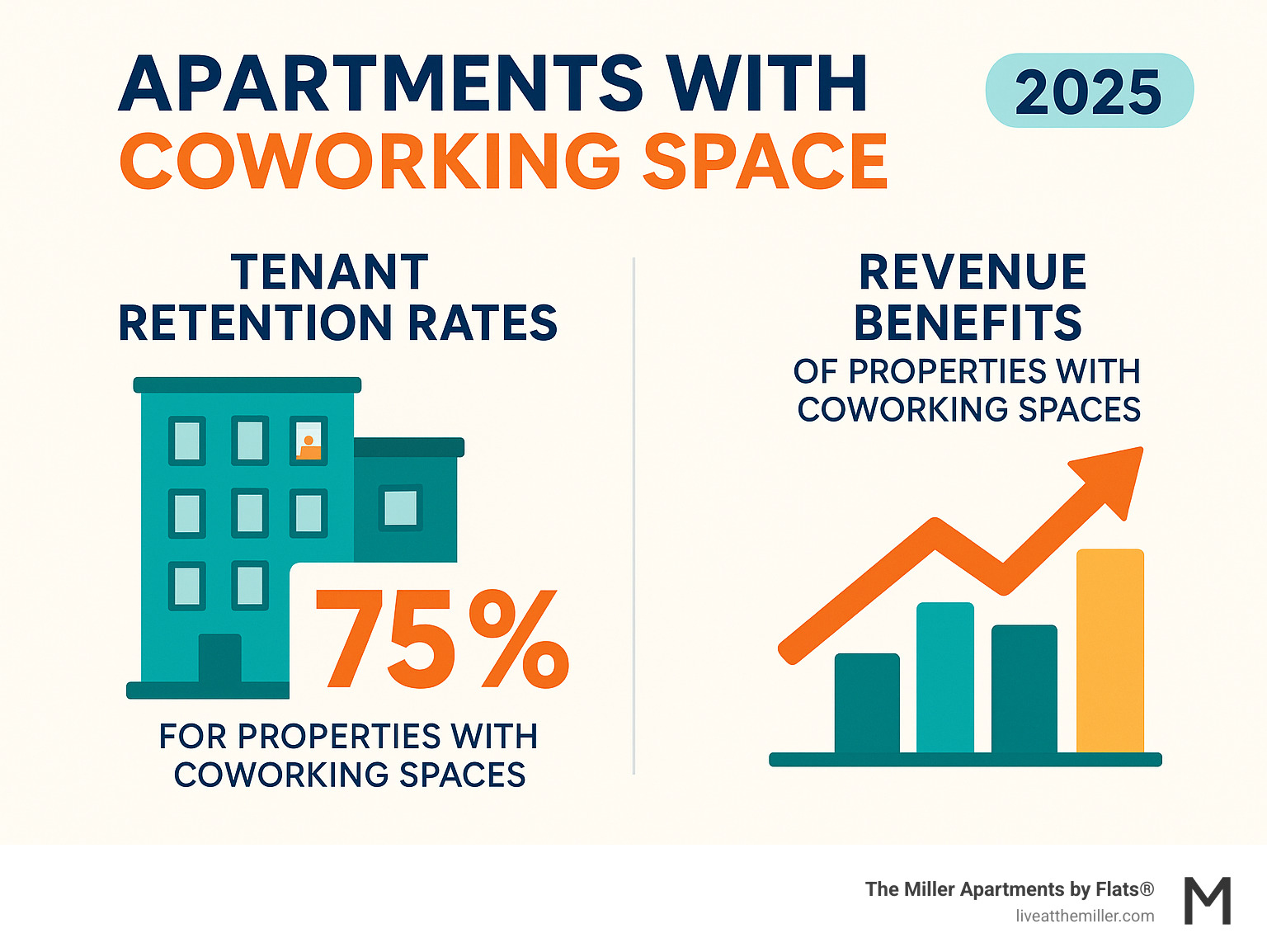
Must-Have Design & Technology Features for In-House Coworking
Creating successful apartments with coworking space means getting the design and technology just right. The best coworking lounges feel like a natural extension of your home while providing everything you need to work productively.
Ergonomic furniture makes all the difference between a space people actually use and one that sits empty. Adjustable office chairs that support your back during long work sessions, standing desks that let you switch positions throughout the day, and properly positioned monitors that don't strain your neck are essential. Scientific research on furniture ergonomics shows that comfortable workspaces can boost productivity by up to 25% while keeping residents healthier and happier.
Flexible layouts are the secret to spaces that work for everyone. Modular furniture that moves easily lets residents reconfigure areas based on what they need. One day the space might host a collaborative brainstorming session, and the next it's set up for focused individual work. Lightweight, mobile pieces make these changes effortless.
Nobody wants to work in a noisy environment, which is why acoustic panels and soundproofing materials are crucial. Open coworking areas need sound management to prevent distractions from phone calls and conversations. Private phone booths require complete sound isolation so residents can take confidential calls without worrying about being overheard.
Smart access systems provide security and convenience rolled into one. Keyless entry through smartphone apps or building access cards ensures only residents can use the space while providing that essential 24/7 access. These systems also help property managers understand usage patterns and optimize the space based on when residents need it most.
Gig-speed Wi-Fi isn't optional – it's the foundation everything else builds on. High-speed internet throughout the space ensures smooth video conferencing, quick file uploads, and seamless connectivity for multiple devices. Backup internet systems prevent those dreaded outages that can derail important work.
Phone rooms and private meeting spaces serve residents who need quiet environments or confidentiality. These spaces should include video conferencing equipment, whiteboards, and comfortable seating for small groups. A simple reservation system helps residents book these premium spaces when they need them.
Green design elements and natural light transform workspaces from sterile office environments into inspiring places people actually want to spend time. Large windows, skylights, and plant walls create environments that boost creativity and reduce stress. Studies consistently show that access to natural light improves sleep quality and overall job satisfaction.
The best coworking spaces blend modern apartment interior design ideas with functional workspace requirements. This creates environments that feel more like high-end lounges than traditional offices, helping residents feel comfortable and relaxed while maintaining professional productivity.
How Owners Monetize & Add Value Through Coworking Amenities
Property owners are finding that apartments with coworking space aren't just tenant perks—they're smart business investments that generate multiple revenue streams while boosting property values.
The most straightforward approach involves amenity fees bundled into rent. Residents gladly pay these fees because they understand the value. When you consider that external coworking memberships can cost hundreds of dollars monthly, the bundled approach feels like a bargain. This creates steady, predictable income for property owners while keeping tenants happy.
Tiered membership models add another layer of revenue potential. Basic coworking access might come standard with every lease, but premium features command additional fees. Think private office hours, guest privileges, or extended access to meeting rooms. This flexibility lets residents choose what they need while maximizing revenue opportunities.
Opening spaces to non-residents through day passes brings in external revenue. Local freelancers, traveling professionals, and remote workers will pay for access to professional-grade facilities. This strategy introduces potential future residents to your building while generating immediate income from underused space.
Event rentals transform coworking areas into versatile revenue generators. Corporate workshops, networking meetups, and educational seminars need professional spaces with presentation technology and catering capabilities. These bookings can command premium rates, especially during evenings and weekends when resident usage typically drops.
Sponsorship partnerships with local businesses create win-win situations. Coffee roasters might sponsor the café area, while office supply companies could provide branded materials. These relationships offset operational costs while delivering valuable services that residents actually want.
The real magic happens with premium lease rates for units with improved coworking access. Apartments with dedicated home office spaces or priority booking privileges naturally command higher rents. This positioning can significantly increase property value while attracting professionals who view workspace access as essential.
The comprehensive approach to amenities that includes coworking transforms properties from simple housing into lifestyle destinations. This positioning attracts tenants willing to invest in convenience and community, creating sustainable competitive advantages in crowded rental markets.
Smart property owners recognize that coworking amenities pay for themselves through improved tenant retention, reduced vacancy rates, and justified premium pricing. The upfront investment in quality design and technology delivers returns through multiple channels while building stronger resident communities.
Case Studies, Resident Profiles & Future Trends
The real magic of apartments with coworking space comes to life through the stories of people who call these communities home. From digital nomads to growing families, these spaces are changing how different groups of people live and work.
Digital nomads have found their perfect match in coworking-equipped apartments. These location-independent professionals can explore new cities while maintaining the consistency they need to stay productive. Instead of hunting for coffee shops with decent Wi-Fi or paying for expensive coworking memberships, they can book month-long stays with guaranteed access to professional workspace and instant community connections.
Freelancers and consultants thrive in these environments because of the natural networking opportunities. Picture this: a graphic designer grabs coffee in the coworking lounge and starts chatting with a marketing consultant from the third floor. Before you know it, they're collaborating on projects and referring clients to each other. These organic business relationships simply don't happen in traditional apartment buildings where neighbors barely make eye contact.
Hybrid employees represent perhaps the fastest-growing segment of residents. They love having the flexibility to work from home without sacrificing professional environments. When they need to host an important client video call, they can book a private meeting room. When their company doesn't require them in the office, they can still maintain productivity and professional boundaries.
Families with remote-working parents have finded these spaces solve the age-old challenge of balancing work and family life. Parents can work productively in the coworking lounge while children play in adjacent family areas, or retreat to soundproof phone booths for important calls without worrying about disrupting naptime or homework sessions.
Students, particularly those in graduate programs or professional studies, benefit tremendously from the quiet study environments and exposure to working professionals. The networking opportunities and potential mentorship relationships prove invaluable for career development.
The success of retrofit projects shows that existing buildings can successfully transform underused spaces into thriving coworking environments. Properties have converted everything from old party rooms to storage areas into productive workspaces. The key lies in flexible design - retractable walls and mobile furniture allow these spaces to serve multiple functions throughout the day.
Sustainability initiatives are increasingly shaping the future of coworking space design. Solar power, energy-efficient lighting, and sustainable materials appeal to environmentally conscious residents while often qualifying buildings for tax incentives and reducing operational costs.
IoT management systems are revolutionizing how these spaces operate. Smart sensors track occupancy patterns, automatically adjust lighting and temperature, and provide valuable data for space optimization. These systems reduce operational costs while creating better user experiences.
Outdoor work terraces and rooftop offices are expanding the concept of coworking beyond indoor spaces. Weather-resistant furniture, reliable Wi-Fi coverage, and weather protection create inspiring outdoor work environments that prove particularly popular in markets with favorable climates.
Remote learning capabilities position coworking spaces as educational hubs where residents can host online courses, attend virtual conferences, or participate in remote training programs using professional-grade technology and quiet environments.
The coworking spaces available in markets like Vancouver, WA, demonstrate how local amenities can be integrated with residential coworking to create comprehensive live-work ecosystems that serve the entire community.
Frequently Asked Questions About Coworking-Ready Apartments
What types of residents flock to apartments with coworking space?
Apartments with coworking space naturally draw people who value flexibility and community in their living arrangements. The biggest group consists of remote workers and hybrid employees who split their time between home and traditional offices. These residents love having a professional workspace just an elevator ride away, especially when they need to hop on video calls or escape household distractions.
Freelancers and small business owners find these communities particularly appealing. Instead of meeting clients in coffee shops or their personal apartments, they can use dedicated meeting rooms that add credibility to their businesses. Many find that their best clients and collaborators live right down the hall.
Young professionals in creative fields like marketing, design, and tech appreciate the 24/7 access and social atmosphere. They often work unconventional hours and enjoy the flexibility to work late or start early without worrying about building access. The coworking lounge becomes their social hub, helping combat the isolation that remote work can bring.
Parents working from home find these spaces essential for maintaining sanity and productivity. They can take important calls in soundproof phone booths while staying close enough to handle childcare responsibilities. The separation between work and family life becomes much clearer when there's a dedicated professional space to retreat to.
Graduate students and career changers also gravitate toward these communities. The exposure to various professionals creates natural mentorship opportunities, while the quiet study environments support focused learning and development.
How do in-building coworking lounges compare with external offices?
The convenience factor alone makes in-building coworking lounges incredibly appealing. There's no commute stress, no parking headaches, and no rushing to make it to meetings on time. Residents can grab coffee at home, take the elevator down, and be at their desk within minutes.
Cost savings add up quickly when you eliminate external office expenses. While residents pay amenity fees, these typically cost less than standalone coworking memberships, especially when you factor in saved commuting costs, parking fees, and gas money. The bundled approach often includes perks like printing, coffee, and meeting room access that would cost extra elsewhere.
The 24/7 access gives residents a huge advantage over external facilities. Need to work at 6 AM or 11 PM? No problem. Weekend project deadlines? The space is always available. This flexibility proves invaluable for anyone managing multiple time zones or working intensive schedules.
However, external coworking spaces do offer broader professional networks. Some residents use both strategically - maintaining their in-building workspace for daily tasks while occasionally using external spaces for specific networking events or client meetings.
The community aspect feels different too. Building-based coworking creates deeper relationships because residents share living experiences beyond just work. You might collaborate on a project with someone, then bump into them at the mailboxes or pool. These connections often become genuine friendships rather than just professional relationships.
What legal or zoning issues should developers check first?
Mixed-use zoning requirements often come into play when residential buildings include professional workspace amenities. Some municipalities require special permits for coworking facilities, even when they're restricted to residents only. Getting clarity on these requirements early prevents costly surprises during development.
Fire safety codes and building occupancy limits deserve careful attention. Meeting rooms and collaborative work areas might need different safety equipment or evacuation procedures compared to traditional residential amenities like fitness centers or lounges. Consulting with local fire marshals during the planning phase helps avoid compliance issues later.
Parking requirements can shift when buildings include work-related amenities. Some jurisdictions require additional parking spaces for professional activities, even when restricted to residents. This consideration can significantly impact project feasibility and overall costs.
Noise ordinances need review since coworking spaces might extend operating hours beyond typical residential quiet times. Balancing resident work needs with neighbor relations requires thoughtful planning and possibly soundproofing investments.
Insurance implications should be thoroughly examined. Coworking spaces might require different liability coverage compared to traditional residential amenities. The professional use of these areas could affect property insurance rates and coverage requirements.
Accessibility compliance under the Americans with Disabilities Act applies to coworking spaces, which must meet commercial accessibility standards. This includes wheelchair access, accessible restrooms, and appropriate signage - requirements that may exceed standard residential accessibility features.
Conclusion
The world of residential living is changing, and apartments with coworking space are leading the charge. These innovative communities represent more than just a trend—they're a response to how we actually want to live and work in today's world.
Think about it: why should you spend hours commuting to an office when you could take an elevator to a beautiful workspace? Why settle for working from your kitchen table when you could have access to ergonomic furniture, high-speed internet, and a community of like-minded professionals?
The demand for these integrated live-work environments keeps growing because they solve real problems. Remote work isn't going anywhere, and hybrid schedules are becoming the norm across industries. Properties that recognize this shift and create thoughtful coworking amenities are attracting the most desirable residents while building lasting competitive advantages.
The design elements that make these spaces successful aren't complicated—they're just thoughtful. Flexible furniture that adapts to different work styles, acoustic panels that keep phone calls private, natural light that boosts productivity, and smart technology that makes everything seamless. When these elements come together, they create environments where people genuinely want to spend time.
For property owners, the business case is compelling. These amenities generate revenue through multiple channels while increasing property values and keeping residents happy enough to renew their leases. Buildings with coworking spaces consistently outperform traditional properties in both rental rates and occupancy levels.
The Miller Apartments showcase exactly how this concept works in practice. By seamlessly blending luxury residential living with professional-grade coworking facilities, they've created a community where residents can thrive both personally and professionally. Their approach demonstrates that when you design with intention and focus on what people actually need, you create something truly special.
As the lines between home and work continue to blur, apartments with coworking space will become less of a luxury and more of an expectation. The communities that accept this evolution now will attract the most engaged residents and build the strongest foundations for long-term success.
The future of residential living is here, and it looks a lot like working from home—just better. For more inspiration on creating exceptional residential environments, explore modern apartment building design ideas that complement coworking amenities and improve overall community appeal.
